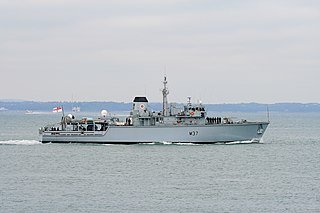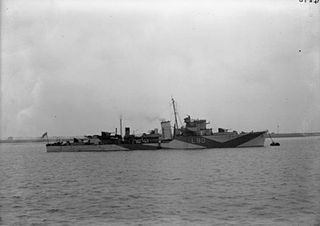Related Research Articles
M30 or M-30 may refer to:
Three ships of the Royal Navy have been named HMS Quorn, all named after the Quorn Hunt.
Three ships of the Royal Navy have been named HMS Atherstone after the town of Atherstone in Warwickshire, or after its hunt:
Three ships of the Royal Navy have been named HMS Cattistock after the Cattistock hunt:
Three ships of the Royal Navy have been named HMS Cottesmore after the Cottesmore hunt:
Two ships of the Royal Navy have been named HMS Middleton after the Middleton hunt:

HMS Bramham (L51) was a Hunt-class destroyer of the Royal Navy laid down in Alexander Stephen and Sons shipyards Govan, Scotland on 7 April 1941. She was launched on 29 January 1942 and commissioned into the Royal Navy on 16 June 1942. She was named after the Bramham Moor Hunt and has been the only Royal Navy warship to bear the name. She was adopted by the town of Beverley in the East Riding of Yorkshire during the Warship Week savings campaign of 1942.

The Sandown class is a class of fifteen minehunters built primarily for the Royal Navy by Vosper Thornycroft. The Sandown class also serve with the Royal Saudi Navy and the Estonian Navy. The first vessel was commissioned into Royal Navy service on 9 June 1989 and all the British ships are named after coastal towns and cities. They have a secondary role as offshore patrol vessels.

HMS Tyne is a River-class offshore patrol vessel built by Vosper Thornycroft in Southampton for the Royal Navy to serve as a fishery protection unit within the United Kingdom's waters along with her two sister ships Mersey and Severn. All three were commissioned into service in 2003 to replace the five older Island-class patrol vessels.

HMS Ledbury, the second ship of the name, is a Hunt-class mine countermeasures vessel of the Royal Navy. She was launched in December 1979 and commissioned on 11 June 1981, the second ship of her class. She cost £65 million at time of building, which was at the time the most expensive cost-per-metre for any class of ship built by the Royal Navy. Most of this cost went into the research and development of Ledbury's glass reinforced plastic hull.

HMS Chiddingfold is a Hunt-class mine countermeasures vessel of the British Royal Navy. She was launched in October 1983 by her sponsor, Lady Anne Kennon, and formally entered the service of the Royal Navy in October 1984. Chiddingfold is a minehunter, and her purpose is to find and destroy mines, not only in a time of war but also in peacetime. There are about a quarter of a million mines still active from the Second World War alone and they pose a major threat to both military and civilian ships. Chiddingfold is able to enter some types of minefields without the mines detonating. This is because she is made of glass-reinforced plastic and all fixtures within the ship are made of non-ferrous metals, keeping the ship's magnetic signature to the bare minimum.

HMS Ledbury was an escort destroyer of the Hunt class Type II. The Royal Navy ordered Ledbury's construction two days after the outbreak of the Second World War and J. I. Thornycroft Ltd laid down her keel at their Southampton yard on 24 January 1940. Air raid damage to the yard delayed her construction and she did not launch until 27 September 1941. Her initial assignment was to perform escort duties between Scapa Flow and Iceland. She remained in this theatre for the first part of the war, during which time she served with the ill-fated Arctic convoy PQ 17 in June 1942, from which twenty-four ships were lost.

Lieutenant Commander Roger Percival Hill, DSO, DSC, was a commander in many famous destroyers of the Royal Navy during the Second World War. Hill served in crucial theatres of the war, being present in the Arctic convoys, the Mediterranean Campaign and Malta Convoys, as well as playing a supporting role aboard HMS Jervis during the Normandy landings.
HMS Ross was a Hunt-class minesweeper of the Aberdare sub-class built for the Royal Navy during World War I. She was not finished in time to participate in the First World War and survived the Second World War to be sold for scrap in 1947.
Two ships of the Royal Navy have been named HMS Hurworth
Two ships of the Royal Navy have borne the name HMS Chiddingfold after the fox hunt at Petworth, Sussex:
Three ships of the Royal Navy have been named HMS Bicester, named after Bicester, Oxfordshire.

HMS Derwent was a Hunt-class Type III destroyer escort of the Royal Navy. She was built by Vickers-Armstrongs, in Barrow-in-Furness, and served during the Second World War. In March 1943, she was badly damaged while anchored in Tripoli harbour by aircraft and beached to prevent her from sinking. Temporarily repaired and towed to England, further repair work was halted in January 1945, and she was broken up for scrap in 1947.
References
- ↑ "HMS Ledbury (M30) | Royal Navy". royalnavy.mod.uk. 28 April 2023.